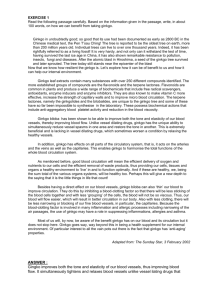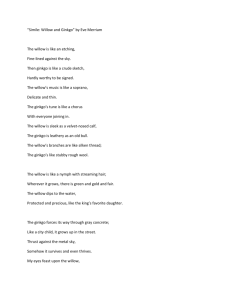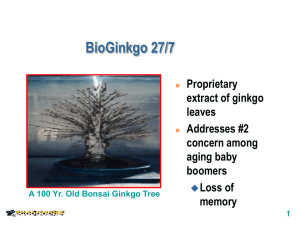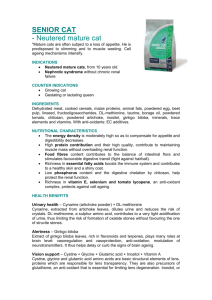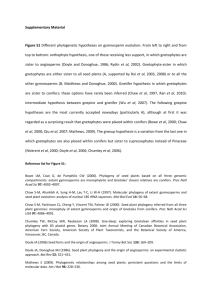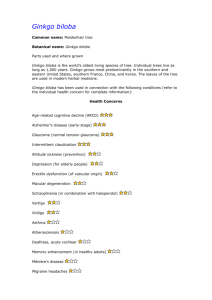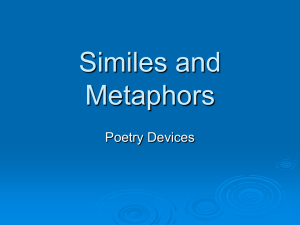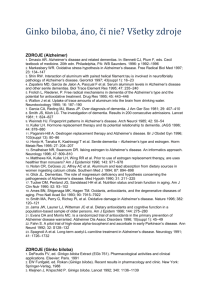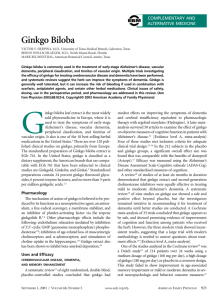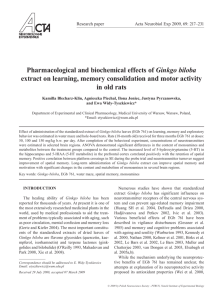The Effect of Different Concentrations of Ginkgo biloba on the
advertisement
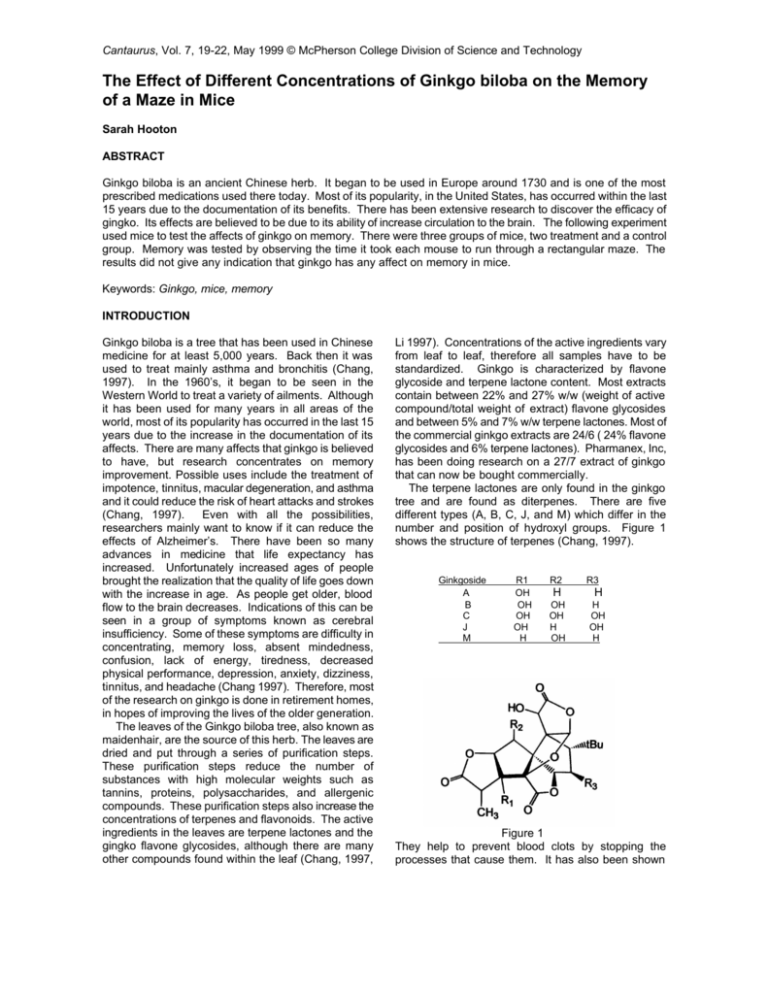
Cantaurus, Vol. 7, 19-22, May 1999 © McPherson College Division of Science and Technology The Effect of Different Concentrations of Ginkgo biloba on the Memory of a Maze in Mice Sarah Hooton ABSTRACT Ginkgo biloba is an ancient Chinese herb. It began to be used in Europe around 1730 and is one of the most prescribed medications used there today. Most of its popularity, in the United States, has occurred within the last 15 years due to the documentation of its benefits. There has been extensive research to discover the efficacy of gingko. Its effects are believed to be due to its ability of increase circulation to the brain. The following experiment used mice to test the affects of ginkgo on memory. There were three groups of mice, two treatment and a control group. Memory was tested by observing the time it took each mouse to run through a rectangular maze. The results did not give any indication that ginkgo has any affect on memory in mice. Keywords: Ginkgo, mice, memory INTRODUCTION Ginkgo biloba is a tree that has been used in Chinese medicine for at least 5,000 years. Back then it was used to treat mainly asthma and bronchitis (Chang, 1997). In the 1960’s, it began to be seen in the Western World to treat a variety of ailments. Although it has been used for many years in all areas of the world, most of its popularity has occurred in the last 15 years due to the increase in the documentation of its affects. There are many affects that ginkgo is believed to have, but research concentrates on memory improvement. Possible uses include the treatment of impotence, tinnitus, macular degeneration, and asthma and it could reduce the risk of heart attacks and strokes (Chang, 1997). Even with all the possibilities, researchers mainly want to know if it can reduce the effects of Alzheimer’s. There have been so many advances in medicine that life expectancy has increased. Unfortunately increased ages of people brought the realization that the quality of life goes down with the increase in age. As people get older, blood flow to the brain decreases. Indications of this can be seen in a group of symptoms known as cerebral insufficiency. Some of these symptoms are difficulty in concentrating, memory loss, absent mindedness, confusion, lack of energy, tiredness, decreased physical performance, depression, anxiety, dizziness, tinnitus, and headache (Chang 1997). Therefore, most of the research on ginkgo is done in retirement homes, in hopes of improving the lives of the older generation. The leaves of the Ginkgo biloba tree, also known as maidenhair, are the source of this herb. The leaves are dried and put through a series of purification steps. These purification steps reduce the number of substances with high molecular weights such as tannins, proteins, polysaccharides, and allergenic compounds. These purification steps also increase the concentrations of terpenes and flavonoids. The active ingredients in the leaves are terpene lactones and the gingko flavone glycosides, although there are many other compounds found within the leaf (Chang, 1997, Li 1997). Concentrations of the active ingredients vary from leaf to leaf, therefore all samples have to be standardized. Ginkgo is characterized by flavone glycoside and terpene lactone content. Most extracts contain between 22% and 27% w/w (weight of active compound/total weight of extract) flavone glycosides and between 5% and 7% w/w terpene lactones. Most of the commercial ginkgo extracts are 24/6 ( 24% flavone glycosides and 6% terpene lactones). Pharmanex, Inc, has been doing research on a 27/7 extract of ginkgo that can now be bought commercially. The terpene lactones are only found in the ginkgo tree and are found as diterpenes. There are five different types (A, B, C, J, and M) which differ in the number and position of hydroxyl groups. Figure 1 shows the structure of terpenes (Chang, 1997). Ginkgoside A B C J M R1 OH OH OH OH H R2 R3 H H OH OH H OH H OH OH H Figure 1 They help to prevent blood clots by stopping the processes that cause them. It has also been shown 20 Cantaurus that they increase the body’s ability to use glucose (Rothfeld, 1998). These also contribute to the effectiveness of the gingko by competing with the platelet activating factor (PAF). Inhibiting the PAF may be the reason for gingko’s ability to improve blood flow. Flavonoids give fruits and vegetables some of their color, taste and aroma. The ginkgo flavonoids get their effect from their antioxidant properties. They are scavengers of oxygen-derived free-radicals. The accumulation of tissue damage due to the free-radicals has been shown to be one of the cause of the aging process (Petkov, 1993). Flavonoids reduce the stickiness of platelets and increase the strength of blood vessel walls. Figure 2 shows structure of flavone glycosides. In my study I tested the effects of a ginkgo extract that was 24% flavone glycosides and consisted of no terpene lactones. I wanted to know if ginkgo would decrease the time it took mice to run through a maze. I had a control group and two test groups. The test groups received two different concentrations of ginkgo. I hypothesized that the final times of the mice receiving the largest concentration of ginkgo would be less than those of the mice in the control group. I also thought that the time for the high dose group would be lower than the low dose group. There were many difficulties during the course of the research that I feel had some bearing on the results. These circumstances include weather and deaths of unknown origin. Due to all the difficulties the research did not produce any significant results. Figure 2 MATERIALS AND METHODS Winter (1991) performed an experiment using a ginkgo extract called EGb 761, which is a 24/6 extract that was given to female albino mice. In this experiment there were three groups. A control group and two test groups, one received the ginkgo four weeks before the conditioning period and the other received the ginkgo eight weeks before. The method of testing had the mice having to press a specific sequence of levers in order to receive food. Winter concluded that EGb 761 improved the mice’s ability in the two-response sequence. She stated that frequency increased and the number of errors decreased with the administration of ginkgo. Although the effects of Ginkgo seem to be wonderful it is important to remember that there is a lot research left to do. Herbs are not approved by the FDA (Food and Drug Administration), because they are naturally occurring. Although this may make it easier to obtain the herbs, it also means that there is no regulation of what goes into the capsules that go on the shelves. There are also no side effects that have been associated with the use of Ginkgo, but if a person is taking any type of blood thinner (for example, Coumadin), it is important not to take ginkgo because it acts as a blood thinner. There has only been one death associated with the use of nutritional substances and that was due to the over use of niacin by a mentally unstable person. Other than that, nutritional substances, including herbs, have shown to be relatively safe, but people should not be over estimate the power of herbs before more research has been conducted. A study involving the herb Ginkgo Biloba was performed on 34(20 females and 14 males), 6 month old CD 1 mice. The mice were given two weeks to adapt to the environment before any testing was started. 45 males were initially ordered and then 21 females had to be ordered. The males and females were each separated into 3 groups; a control group, a treatment group that received 327.2 µg of ginkgo extract per week, and another treatment group that received 436.3 µg of ginkgo extract per week. The Figure 1 ginkgo used was Spring Valley Ginkgo Biloba liquid, which contains 24% flavonoid but no terpenes. The mice were given one pellet of food a day. After 2 weeks I did the initial timing of each mouse running through the maze. I found an internet site that allowed me to create my own maze (flint.umich.edu/ Departments/TS/crac/maxe.form). I created a pattern that I thought would be appropriate as far as difficulty and built it. Figure 3 is the pattern that I used. Figure 3. Once I had run each mouse through the maze, the treatment groups were given a dose of the ginkgo. I looked at research that had been done on humans and Ginkgo biloba and Memory – Hooton scaled down the dosage for mice using weight. For the lower dose group, .03 mL of the liquid were diluted in 50mL of water and then 1 mL of that solution was added to the water that was in their water bottles. The higher dose group was done the same way except that .04 mL of the liquid was added to the 50mL of water. Ginkgo was given to the treatment groups every week and all the mice were run through the maze every 2 weeks. RESULTS The time it took for each mouse to run through the maze decreased from the initial running to the final running. Figure 4 shows the final and initial time for each mouse. Final time (s) Figure 4: Comparison of the Mice using Initial and Final Times in Seconds 1000 500 0 0 200 400 600 800 1000 Initial time (s) Mouse I first applied a t-test to the times of the males and females to determine if there was any significant difference between their times initially and finally. Among the initial time a significant difference was noticed between the males and females, but this significance was not found among the final time. After determining that there was not significant difference between males and females in the end, I combined the results to have a larger sample. I then ran three t-tests comparing the three groups for any significant difference. A test was used to compare the control with the high dose, the control with the low dose, and the high dose with the low dose. I applied an analysis of covariance to take into account the initial times of each mouse. After conducting this test I found no significant difference in the times of the three groups. Figure 5 shows the mean times that have the analysis of covariance portrayed in them. time (s) Figure 5: Adjusted Means of Final Times of Each Group of Mice 200 150 100 50 0 control low dose group DISCUSSION high dose 21 The results of this experiment did not support the hypothesis that I stated earlier. I had a problem with controlling the temperature of the room. I started in a room that had no air-conditioning system and many of the mice died from heat. Then I moved to a room that had an air-conditioner that, unfortunately, froze over every few days. With all the deaths, I had a low number of data points. The final data included eight points for each of the high and low dose groups and nine for the control. Due to this problem, I feel that the opportunity to try the experiment over in a room where the temperature can be regulated would produce more reliable results. According to the data I did collect, gingko did not have any significant affect on memory. The data in Figure 4 does not differentiate between gender or the group. The purpose was just to show that overall each mouse had a lower time in the end than initially. Ideally all the points would lie in the bottom right hand corner of the graph. This would depict all mice having a high time initially but the final time being lower. The initial times were spread out and no trend could be distinguished. While the final times were more concentrated on the lower end of the scale. One very important point of interest was that the female high dose group seemed to suffer the most deaths. By the end of the experiment there were only two members of the group still alive. This could have been due to a toxicity in ginkgo, although none of the literature I read mentioned any possible toxicity ACKNOWLEDGEMENTS I would like to thank Mr. Stine for the contributions that made this research possible. I would also like to thank the Pharmanex company who supplied me with a number of research articles on ginkgo. LITERATURE CITED Chang J, Chang M. 1997. Medicinal uses of ginkgo biloba. Today’s Therapeutic Trends 15(1): 63-74. Ellnain-Wojtaszek M. 1997. Qualitative analysis of free and liberated by hydrolysis of phenolic acids from ginkgo biloba. Acta Poloniae pharmaceutica 54(3): 225-32. Li CL and Wong YY. 1997. The bioavaliability of ginkgosides in ginkgo biloba extracts. Planta Medica 63: 563-5. Pang Z, Pan F, and He S. 1996. Ginkgo biloba: history, current status, and future aspects. J Alternative and Complementary Medicine 2(3): 359-363. Petkov VD, Kehayov R, Belcheva S, Konstantinova E, Petkov VV, Getova D, and Martkovska V. 1993. 22 Cantaurus memory effects of standardized extracts of panax ginseng, ginkgo biloba, and their combination gincosan. Planta Medica 59: 106-14. Porsolt RD, Martin P, Lenegre A, Fromage S, and Drieu K. 1990. Effects of an extract of ginkgo biloba on “learned helplessness” and other models of stress in rodents. Pharmacology, Biochemistry, & Behavior 36: 963-71. Rothfeld GS, LeVert S. Ginkgo biloba. 1998. New York: Dell 249 p. Winter E. 1991. Effects of an extract of ginkgo biloba on learning and memory in mice. Pharmacology, Biochemistry, & Behavior 38: 109-14.
